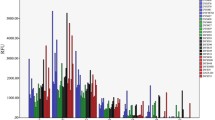Abstract
The EX27 System is a 6-dye (i.e., FAM, HEX, TAMAR, ROX, VIG, and SIZ-500) kit that combines the 24 autosomal STR loci (i.e., D3S1358, D13S317, D7S820, D16S539, D1S1656, Penta E, TPOX, TH01, D2S1338, CSF1PO, Penta D, D10S1248, D19S433, vWA, D21S11, D18S51, D6S1043, D8S1179, D5S818, D12S391, FGA, D22S1045, D2S441, SE33) with a Y-STR locus (DYS391), an Indel site (YIndel) and Amelogenin, which is designed to amplify DNA from extracts as well as direct amplification from substrates. The new system contains most of the widely used autosomal STR loci around the world and is sensitive to the male component in mixtures and is more accurate in gender determination owing to the DYS391 and YIndel.
To demonstrate the suitability for personal identification and parentage testing, the system was validated for sensitivity of detection, species specificity, inhibitor tolerance, DNA mixtures, reproducibility study, and concordance studies based on the SWGDAM developmental validation guidelines. In view of the results, the EX27 System is a robust and reliable amplification kit which can be used for human identification testing.



Similar content being viewed by others
References
Hares DR (2012) Expanding the CODIS core loci in the United States. Forensic Sci Int Genet 6(1):e52–e54
Tozzo P, Giuliodori A, Corato S, Ponzano E, Rodriguez D, Caenazzo L (2013) Deletion of amelogenin Y-locus in forensics: literature revision and description of a novel method for sex cnfirmation. J Forensic Legal Med 20(5):387–391
Scientific Working Group on DNA Analysis Methods (SWGDAM), Validation Guidelines for DNA Analysis Methods, 2013. Available from: http://swgdam. ord/SWGDAM Validation Guidelines Approved Dec 2012.pdf
Zhao J, Wang Y, Wang G, Ma Y, Shi H, Wen J, et.al (2015), Application of the microwave digestion-vacuum filtration-automated scanning electron microscopy method fordiatom detection in the diagnosis of drowning. J Forensic Legal Med 33:125–128.
Huston K.A.(1998), Statistical analysis of STR data Available from: https://www.promega.com/resources/profiles-in-dna/1998/statistical-analysis-of-str-data
Magnuson VL, Ally DS, Nylund SJ, Karanjawala ZE, Rayman JB, Knapp JI, et.al. (1996). Substrate nucleotide-determined non-templated addition of adenine by Taq DNA polymerase: implications for PCR-based genotyping and cloning. BioTechniques 21(4):700–709.
Akane A, Matsubara K, Nakamura H, Takahashi S, Kimura K (1994) Identification of the heme compound copurified with deoxyribonucleic acid (DNA) from bloodstains, a major inhibitor of polymerase chain reaction (PCR) amplification. J Forensic Sci 39(2):362–372
Tsai YL, Olson BH (1992) Detection of low numbers of bacterial cells in soils and sediments by polymerase chain reaction. Appl Environ Microbiol 58(2):754–757
Rossen L, Nørskov P, Holmstrøm K, Rasmussen OF (1992) Inhibition of PCR by components of food samples, microbial diagnostic assays and DNA-extraction solutions. Int J Food Microbiol 17(1):37–45
Hennessy LK, Mehendale N, Chear K, Jovanovich S, Williams S, Park C, et.al. (2014). Developmental validation of the GlobalFiler ® express kit, a 24-marker STR assay, on the RapidHIT ® system, Forensic Sci Int Genet, 13: 247–258.
Ensenberger MG, Lenz KA, Matthies LK, Hadinoto GM, Schienman JE, Przech AJ, et.al. (2016). Developmental validation of the PowerPlex® fusion 6C system. Forensic Sci Int Genet. 21:134–144.
Kraemer M, Prochnow A, Bussmann M, Scherer M, Peist R, Steffen C (2017) Developmental validation of QIAGEN Investigator®24plex QS kit and Investigator® 24plex GO! Kit: two 6-dyemultiplex assays for the extended CODIS core loci. Forensic Sci Int Genet 29:9–20
Bright JA, Taylor D, Curran JM, Buckleton JS (2013) Developing allelic and stutter peak height models for a continuous method of DNA interpretation. Forensic Sci Int Genet 7(2):296–304
Criteria for the human fluorescent STR multiplex PCR reagent. GA/T 815–2009. China. Available from: http://www.bjstandard.com/standard/168830.html
Acknowledgements
The authors would like to thank the donors who generously provide samples for this validation study and thank support from the Ministry of Public Security application innovation projects (NO. 2011YYCXGDST076) as well as Science and Technology project of Guangdong Province (NO. 2010A060801001).
Author information
Authors and Affiliations
Corresponding author
Rights and permissions
About this article
Cite this article
Li, S., Chen, L., Wang, Y. et al. Developmental validation of a 6-dye STR kit with 27 loci. Int J Legal Med 132, 335–342 (2018). https://doi.org/10.1007/s00414-017-1586-6
Received:
Accepted:
Published:
Issue Date:
DOI: https://doi.org/10.1007/s00414-017-1586-6




